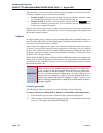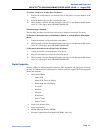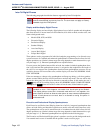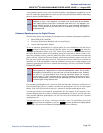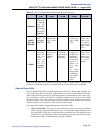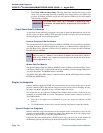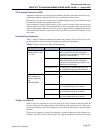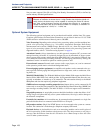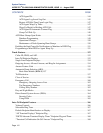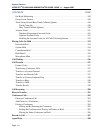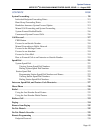
Hardware and Endpoints
INTER-TEL
®
CS-5200/5400 ADMINISTRATOR GUIDE, ISSUE 1.1 – August 2005
Page 108 Optional System Equipment
line port must support Caller ID or Calling Line Identity Presentation (CLIP) as defined by
current industry-standard specifications.
Optional System Equipment
The following optional equipment can be purchased and installed with the Inter-Tel system.
Complete specifications and installation instructions are provided in the Inter-Tel CS-5200/
5400 Installation and Maintenance Manual, part no. 580.8001.
Voice Processing: Depending on the selected voice processing option, provides multiport inte-
grated voice processing features (e.g., Voice Mail, Automated Attendant, Hunt Group
announcement and overflow, SMDR storage, Record-A-Call, etc.) Inter-Tel supports three
types of voice processing systems. For more information about voice processing systems and
supported features, refer to “Voice Processing Systems” on page 16.
Attendant Console: Allows Attendants to use their personal computers (PC) to answer and
manage incoming call traffic. It is primarily designed for use by Attendants of larger system-
sthose systems with so many stations that using Mini-DSS Units is not practical. However, due
to its enhanced functionality, including electronic text messaging and directory dialing, the
Attendant Console is an attractive option for smaller systems as well.
External music sources: External music sources (radios, tape players, etc.) can be connected
to the system to provide music-on-hold and background music.
External paging speaker equipment: An amplifier and speakers can be connected to the sys-
tem to provide external paging and background music to large areas, such as warehouses, load-
ing docks, etc.
Mini-DSS (Model 8416): The IP Model 8660 and digital Model 8560 support the Mini-Direct
Station Select (Mini-DSS) Unit, which provides 16 programmable buttons that allow the user,
typically an attendant, to monitor up to 16 extensions. The unit attaches directly to the Model
8660 phone and does not require any peripheral equipment.
SMDR and error message recording output devices: Output devices can be connected by IP
socket only to record the data generated by the Station Message Detail Recording (SMDR) and
error message recording features. The Inter-Tel 5000 v1.1 does not support serial communica-
tion.
Surge/spike protector: A surge/spike protector should be installed to reduce the effects of AC
voltage surges and spikes that may cause system malfunctions, false logic, and/or damage to
the electronic components.
Facsimile (fax) machine: A fax machine may be connected and programmed to a single line
port built into the chassis or connected with an IP-SLA or SLA port.
Off-premises stations: Single line DTMF phones can be connected to the system at a remote
location. The connection is made through a telephone company OPX trunk.
Playback devices: A playback device such as an answering machine can be used in place of
the voice processing system interface to help process calls. The device answers a call, plays a
message, then disconnects from the call or transfers it to a Hunt Group to allow the caller
access to other system resources.
NOTE
Some third-party device documents claim to support Caller ID, but in fact do not.
Because an extension is shorter than a 10-digit number that the device would nor-
mally receive, the device may not be capable of receiving the Caller ID informa-
tion. Also, some third-party devices may display the extension in a telephone
number format rather than as an extension number. For example, an extension of
11023 may appear as “110-23,” or “- 1-1023,” etc.



